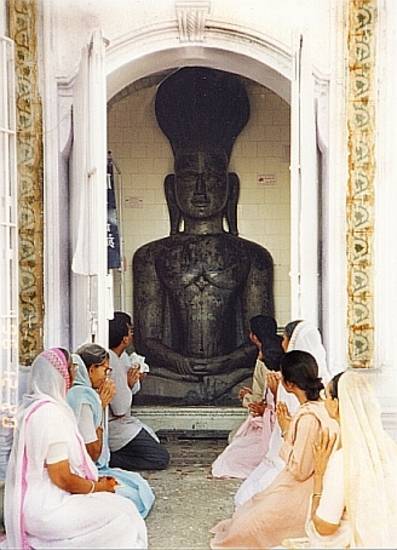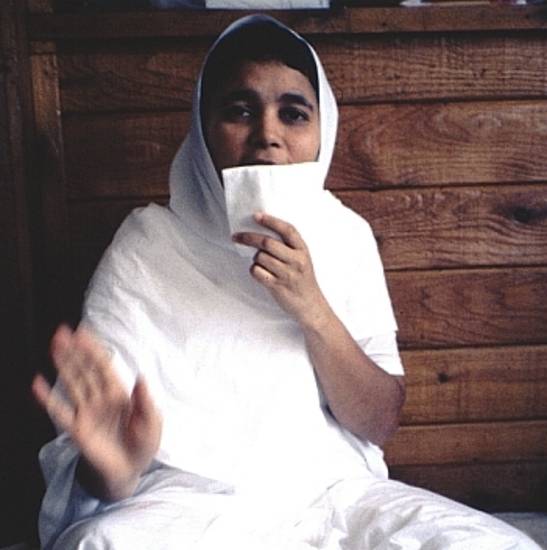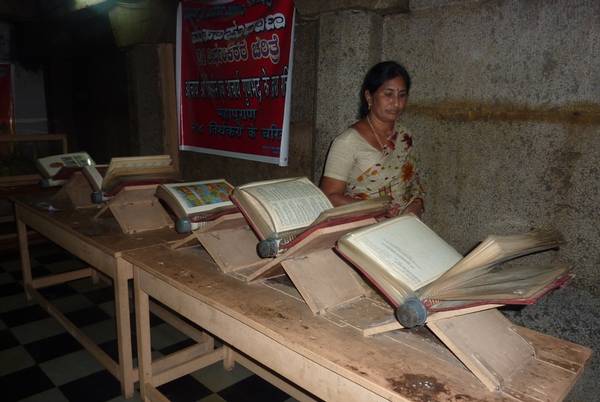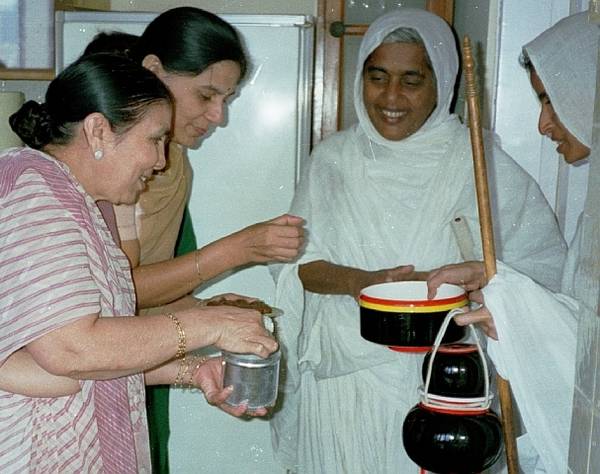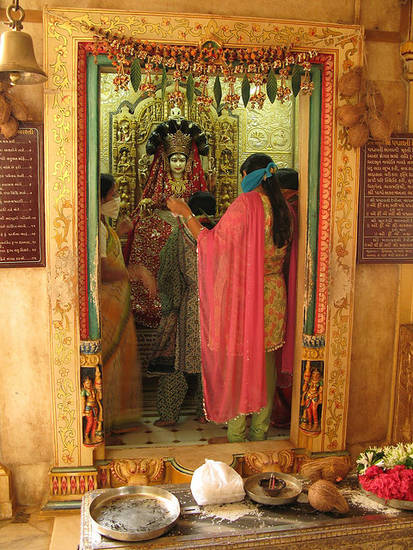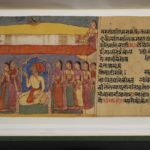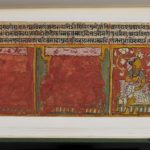Article: Women in the Jain tradition
The religious status of women is one of the chief differences between the two principal sects of Digambaras and Śvetāmbaras. It is also a crucial issue in the history of Jainism.
Historically, Jainism’s attitude towards women has shared a view common amongst other Indian and Asian traditions, which see women as innately unequal to men. Counter to these long-established attitudes, Jainism gives women a central role in its ethical and spiritual patterns. For example, the fourfold community that is the foundation of Jain daily life includes lay women as well as lay men, nuns as well as monks. Among Śvetāmbara sects, there tends to be more female mendicants than male. Traditional sources name several distinguished women who play important roles in the tales of the Jinas, while goddesses are significant cultural and religious figures. In addition, the soḷa satī – 16 virtuous women – are female role models whose stories highlight desirable religious qualities.
These conventions are more striking when recalling that historical Jain holy writings were written by men primarily for male readers and listeners. Women’s voices have only been heard since the 20th century and these usually take the form of autobiography rather than philosophical works.
Women lead the key Jain religious activities surrounding food, especially fasting, and often have principal roles in the performance of worship, particularly singing hymns. Jain women are also often the keenest participants in religious festivals.
Despite the vital importance of female activity in Jain religious life and the high proportion of female mendicants, nuns must defer to male colleagues. Frequently, senior nuns have limited authority and are not allowed to preach like monks. One of the most basic Jain beliefs is that each individual is responsible for his or her spiritual condition and thus anyone may read the scriptures, which guide spiritual progress. It is very likely, however, that female Jains generally had lower educational levels than their male counterparts, which must have hindered their scriptural knowledge. Nowadays female education for both nuns and lay women is a focus of disagreement among the sects.
This is partly connected to the main philosophical distinction between the Digambaras and Śvetāmbaras. The capacity of women to achieve liberation from the cycle of rebirth has been hotly debated for around two thousand years, and relates to whether nudity is necessary for salvation. The sectarian dispute over whether the 19th Jina, Mallī, was male or female symbolises disagreements about female liberation.
Centrality of women from the start
No sound information is available before the time when Mahāvīra, the main expounder of the Jain doctrine, organised the community of Jains. From the start, this community, known as ‘the fourfold sangha’, included women as two of its components:
The male elements of the community are lay men and monks. Thus both main sects recognise that women form two of the four essential parts of society.
In contrast to Buddhism, the Jain tradition has no text showing that the idea of a nuns’ order could ever have caused difficulty. Nuns have always been there and in fact they always outnumber monks in traditional statistics for Jain communities surrounding the Jinas, at least among Śvetāmbaras.
Indeed, the names of individual respected women appear in early sources and are depicted in the narrative literature as ideal types of virtue and generosity – the satī. Examples include the head nun of Mahāvīra’s community, Candanā or Candanābālā, who had first come to notice by offering him an appropriate gift of food. Sulasā and Revatī were at the head of his female lay followers. Revatī was known for having offered medicine to Mahāvīra when his life was at risk because of his enemy Gośāla.
Male or male-oriented sources
This express recognition of the vital place of women in Jainism is more notable since women’s voices are seldom heard directly. This is because the sources are almost all written by men or are male-oriented.
In the 20th century a few highly charismatic nuns have been able to express themselves through their autobiographies, for example Āryikā Jñānamati, or in religious pamphlets. Yet no woman is known to have composed any truly groundbreaking treatise on dogma.
Even so, a few women are famous for having inspired innovative work. This is the case for Mahattarā Yākinī, a legendary figure who is said to have been the muse of the eighth-century teacher and scholar Haribhadra.
Nuns and religious hierarchy
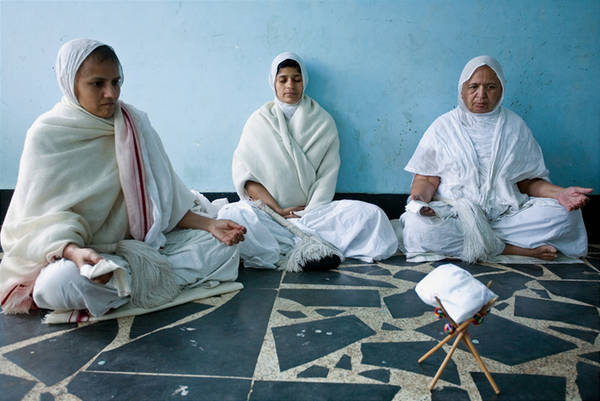
Śvetāmbara nuns meditate
Image by Claude Renault © CC BY 2.0
The high number of nuns in the Jain orders has not had a positive impact on their rank within these orders. In fact, nuns usually have lower places in the hierarchy of monasticism than monks, with high-ranking nuns having less authority than their male equivalents.
It is rather rare to see female mendicants take part in public activities such as preaching or scriptural discussions.
Monastic codes
Women’s difficulties in rising to high rank within the monastic hierarchy are first shown by the texts discussing the monastic code that is part of the Śvetāmbara canon. Even though no statement seems to record any fundamental inequality between monks and nuns, this code rests on the underlying belief that a woman, being unsteady by nature, needs more control and thus more rules than a man.
Individual monastic orders have both men and women members. Small groups of monks or nuns come under the authority of one of them. But female groups as a whole are generally supervised by men members and leading nuns are appointed by monks.
Among the Digambaras, where the place of women is always more inferior than among other Jain orders, a nun – āryikā – is initiated by a monk and traditionally becomes a member of a male mendicant’s ‘lineage’. In some cases, a Digambara nun may be an independent group leader and initiate her own disciples, female or even males.
The general rules for monks and nuns are largely similar. There are, however, additional, stricter rules which limit nuns’ options in their daily routine, especially food regulations.
Besides this, their independence and freedom are limited by a broad subordination to the monks, which takes the following forms:
- even after long years as a nun they may be under the authority of junior monks
- they need to serve longer than their male colleagues to reach high positions in the religious hierarchy
- nuns have their own religious titles – guruṇī, gaṇinī, pravartinī – which refer to their function as leader of a small group or unit only. However, they all imply an inferior rank to those of monks.
One exceptional case, which has given rise to controversy, is that of the nun Candanā, who was appointed ācārya. This title was bestowed on her by Amar Muni, the creator of the Veerayatan centre in Bihar.
Example of the Terāpantha
That nuns’ religious titles suggest a lower rank than those of monks is exemplified in the organisation of the Terāpanthin movement, a modern subsect of the Śvetāmbaras mostly active in Rajasthan. When it originated in the 18th century a single teacher – ācārya – was the head of both monks and nuns. The regular increase of nuns resulted in the institution of a female-head or pramukhā who commands smaller units. However, her role is that of a co-ordinator in practical matters and she is not considered the female counterpart of the ācārya. He is the decision-making authority and she remains junior to him.
Access to scriptures and education
The stress on individual responsibility for spiritual progress is an important Jain belief. Making spiritual progress relies on knowledge and scriptural knowledge is a key part of this. Customarily, women received and passed on religious teachings orally and through taking leading parts in daily practices such as food preparation and ceremonies of worship. Being able to directly read, meditate on and transmit sacred writings were not crucial elements in women’s traditional roles in the Jain faith. These days, the topic of female education in religious matters is disputed among contemporary Jains, with sects varying in their beliefs and practices.
Nuns and scriptures
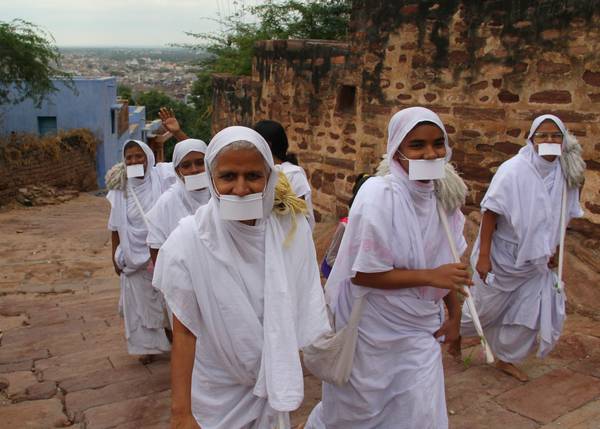
Śvetāmbara Sthānaka-vāsin or Terā-panthin nuns
Image by arjunstc – Arjun © CC BY-NC-ND 3.0
As far as access to sacred scriptures is concerned, there is again no theoretical distinction between nuns and monks. Like Buddhism, Jainism is open to all, differing from the orthodox Hindu tradition, where women are not allowed to read the Vedas. However, the educational level of Jain nuns is very difficult to assess. Hints in manuscript colophons show that some texts were copied to be read by women, whether nuns or lay women, but they remain a minority.
Today, nuns’ and, more broadly, women’s education is a divisive issue, for instance among Jain subsects of the Śvetāmbara group. Some subsects, for example the Terāpanthin and Sthānaka-vāsin, claim that monks and nuns can study all texts. But the Tapā-gaccha sect, for instance, states that nuns’ abilities are lesser and therefore prevents them from studying the Cheda-sūtras, a difficult and controversial group of canonical texts dealing with the monastic code. This same sect does not allow nuns to preach, whereas the Kharatara-gaccha allows it. Even then the number of nuns giving public sermons is limited, considering the global number of nuns. More often, they are seen surrounding the preaching monk and carefully listening to him.
Some prominent nuns of the 20th century, such as Sādhvī Mr̥gāvatī try to use their prestige and influence to promote women’s education. They believe that young girls must undergo a trial period before going through full religious initiation. During this period they should gain at least elementary knowledge not only of Jainism but also of basic disciplines such as Sanskrit and Prakrit grammar or literature.
Promoting women’s education is high on the agenda of the Terāpanthin. This subsect has a special category of nuns called the samaṇi, which is officially free from certain rules restricting their movements and can visit institutions in India or abroad to pursue academic research.
Lay women and scriptures

Indrabhūti Gautama preaches
Image by British Library © CC0 1.0 (Creative Commons Public Domain)
Jain lay women’s book knowledge of the tradition varies according to their social environment. From time to time, resolutions are passed in Jain conferences to encourage women’s education. This was the case during the large lay Jain conference held in 1915 in Sujangadh, near Bikaner in Rajasthan. The ninth resolution passed here called for greater support for women’s education (Cort 1995: 11). In the 17th century one of the conclusions proclaimed during a meeting led by the monk Satyavijaya-gaṇi related to the proper ways to give religious instruction to lay women (Cort 1995: 18).
Principally, women ‘protect or continue the community’ by passing on basic teachings to the younger generations, mainly through telling legends and stories. The old stock is kept alive thanks to new versions in modern-language translations that are widely available in small cheap booklets.
Listening to the daily sermons of monks and nuns, which they normally attend in large crowds, alone or with their family members, is another way in which lay women become familiar with Jain scriptures. They largely outnumber their male colleagues in these circumstances.
Religious hymns form another category of literature in which lay women are prominent. Chanting and reciting hymns are two areas where women take a leading role in both domestic and temple rituals.
Lay women’s roles
Women’s knowledge and place in the community are mostly oriented towards two areas where they dominate, namely the:
- preparation of food
- performance of rituals.
Here, in a reverse of the usual situation, men are completely dependent on them. This is chiefly because they mostly spend much less time at home or at the temple than the female members of the family.
Food – feasting and fasting
In the Jain tradition, food is a major concern because observing specific dietary rules is one of the clearest marks of Jain identity. Thus the woman at home is a guardian or modifier of the tradition through various roles connected with food. These include:
- offering alms to the Jain mendicants who beg at her door, which implies mastery of a detailed sequence of ritualised actions and rules
- preparing meals for the family
- deciding whether a rule such as the one forbidding eating after sunset – rātribhojana – will be observed or not
- knowing which foods should be cooked depending on whether, for example, it is an ordinary day or a festival
- taking full command of the complicated calendar and types of fasts which regulate Jains’ lives. Partly for these reasons, fasting is known as a women’s penance and it is a way for women to gain a reputation for piety and status.
Role of women in worship
There are differences among the subsects as to whether women ought to have the same rights as men in worshipping images.
Fundamentalists among all Śvetāmbara groups hold that they should never be allowed to enter the innermost sanctuary and touch the idols because they can never reach the required degree of purity. The Kharatara-gaccha sect does not authorise women of childbearing years to have direct contact with idols, so, for example, women are not allowed to anoint Jina images with sandalwood paste. Menstruating women, who represent impurity, should not perform worship or undertake pilgrimages to sacred places.
The non-idolatrous groups, however, lay more stress on internal worship so their notions are more egalitarian.
On the other hand, recent studies have stressed that women have true authority in the conduct and performance of ritual itself.
Woman and salvation
The most original contributions of the Jains to world religion are undoubtedly the theological consequences of their conceptions of women and their millennia-old debates about women’s ability to reach salvation.
This contentious issue separates the Digambaras and Śvetāmbaras very deeply and is linked to the question of whether nudity is a prerequisite for liberation.
Reading
- ‘Women in Jainism’
Nalini Balbir - Religion and Women
edited by Arvind Sharma
McGill Studies in the History of Religions series
State University of New York Press; Albany, New York, USA; 1993
- Gender and Salvation: Jaina Debates on the Spiritual Liberation of Women
Padmanabh S. Jaini - University of California Press; Berkeley, California, USA; 1991
- Singing to the Jinas: Jain Laywomen, Maṇḍaḷ Singing and the Negotiations of Jain Devotion
M. Whitney Kelting - Oxford University Press USA; New York, USA; 2001
- Heroic Wives: Rituals, Stories and the Virtues of Jain Wifehood
M. Whitney Kelting - Oxford University Press USA; New York, USA; 2009
- Escaping the World: Women Renouncers among Jains
Manisha Sethi - South Asian History & Culture series; volume 8
Routledge Taylor & Francis Group; London, UK and New Delhi, India; 2011
Links
- Dreams of Triśalā
-
Jainworld.com provides pictures and explanations of the dreams of Queen Triśalā. Women carrying babies who grow up to become Jinas all experience auspicious dreams, which signal the great spiritual leadership of their children. The Digambara sect specifies 16 dreams while the Śvetāmbaras have14 dreams.
- Introduction to Jainism – part 2
-
This extract from a BBC documentary called The Frontiers of Peace explores the relationship between Jain traditions and modernity. A Jain lay man tells how he reconciles his faith with his industrial business interests. A Śvetāmbara monk explains the significance of his monastic broom – known as a rajoharaṇa or oghā – including the eight auspicious symbols wrapped around the handle. A nun leads lay followers in the rite of confession – pratikramaṇa. A young woman creates auspicious symbols in rice as an offering as she talks about her decision to become a nun. This 2010 YouTube video is the second of four parts. See the next part at: www.youtube.com/watch
- Introduction to Jainism – part 3
-
This extract from a BBC documentary on Jainism called The Frontiers of Peace explores the concept of renunciation. The video follows a young woman's decision to become a nun and a rich lay man's faith. The ritual of keśa-loca is filmed, in which monks and nuns pull out their hair. The lay man is shown making the auspicious symbols of the svastika, three dots representing the 'three jewels' of right insight, right knowledge and right conduct and the horizontal crescent of the siddha-śilā, where liberated souls live. This 2010 YouTube video is the third of four parts. See the next part at: http://www.youtube.com/watch?v=670KFhISeUk
- Introduction to Jainism – part 4
-
This extract from a BBC documentary called The Frontiers of Peace explores the mendicant element of the traditional fourfold community. A man talks about his decision to stop being a Jain monk and return to the householder life, while a young woman fulfils her wish to becomes a nun. This 2010 YouTube video is the last of four parts. See the first part at: http://www.youtube.com/watch?v=IPscKFV5yKU
- Re-enactment of the story of Candanabālā
-
This slideshow displays the re-enactment of the story of Candanabālā, who offered Mahāvīra appropriate food to break his fast. Sold into slavery, the beautiful princess has her lovely hair chopped off and is starved for three days. Even so, her first act when released is to offer alms to a passing mendicant. He is Mahāvīra, who becomes the 24th Jina, and he has been fasting for nearly six months. Candanabālā’s act of selfless charity despite her suffering causes her hair to be restored and her true identity revealed. The story of this virtuous woman – one of the soḷa satī – emphasises the importance of offering alms correctly. Acting out such stories is an important part of many Jain festivals. This re-enactment on YouTube was performed by Śvetāmbara Jains in Melbourne, Australia during the festival of Paryuṣaṇ in 2010.
- Mahāvīr Jayantī procession – part one
-
The festival of Mahāvīr Jayantī is often marked with a procession in which images of the 24th Jina Mahāvīra are carried through the streets. This large procession is made up of animals, singers and musicians, dancers and local Jains celebrating the birth of the last Jina. This procession took place in March 2010 in Jaipur, Rajasthan and also featured the message of environmental conservation.
Captured in two parts on YouTube, this is the first part. You can also watch the second part.
- Procession of Mahāvīra idol
-
This 2009 YouTube video shows the procession of a small golden idol of Mahāvīra – rathayātrā – through the streets of New Delhi. The procession takes place during the Digambara festival of Daśa-lakṣaṇa-parvan. The men in orange, some of whom are also crowned, are the prominent lay men who have won the privilege of accompanying the statue in the procession. They put the statue in an ornate shrine on a platform set on a tractor with false horses attached. Before the procession begins, Jain lay women move trays of fire in circles – āratī – offering pūja or worship to the idol. Lay people dance in the procession around the idol, which is fanned by fly-whisks, a sign of high status. Many of the dancers wave bright plastic objects, which are modern equivalents of traditional fly-whisks. The women dressed in orange are the wives of the prominent lay men on the tractor. A model of Bāhubali with vines creeping up his legs is also fanned. Small children ride on the shrine, which is hung with a Jain flag at the back, while musicians and models form part of the procession. Two fully fledged monks take part, accompanied by novice monks in white. At the end of the procession the idol is taken into the temple, placed in front of a large Jina image and given a sacred bath. Food is provided for the participants afterwards. All along, there are various songs or prayers. In the first part, the Pañca-namaskāra-mantra is sung to various tunes, then come hymns in Hindi. For instance, one of them says: ‘Listen to the voice of the Jinas’.
- Mahāvīr Janam Divas celebration
-
This YouTube slideshow of the celebrations of Paryuṣaṇ in Melbourne, Australia in 2010 illustrates some of the features of the eight-day long festival. Sculptures of the 14 auspicious dreams experienced by Mahāvīra’s mother are suspended from the ceiling on the fifth day of Paryuṣaṇ – Mahāvīr Janam Divas, which celebrates the birth of Mahāvīra, the 24th Jina. The sculptures are venerated in turn by all the festival participants, sometimes by being held to the crown of the head, seat of spirituality in Indian culture. Then auctions – bolī – are held to decide who should perform various ceremonies. The most important and expensive auction is over the right to take home the image of the infant Mahāvīra for the last three days of the festival. Everyone can rock the cradle holding the idol of the baby Jina, which takes pride of place in the display.
- Śruta-pañcamī – part 2
-
The procession of holy texts in the annual Digambara festival of knowledge – Śruta-pañcamī – is the main subject of this YouTube video. As the centre of festivities, the sacred books are decorated with flower garlands. They are placed on a model elephant, protected from the sun by a canopy and fanned with fly-whisks, all symbols of royalty. The Jain flag is waved in front. Lay Jains, many dressed in orange – the colour of spirituality in India – take part in the noisy procession. Some carry the metal sculptures of the 12 dreams of a Jina’s birth. A nude monk, holding his peacock-feather broom, and white-clad nuns also participate. The procession ends with a display of holy books, the reflection of which is ritually anointed, and a rite of worship in which the auspicious symbol of the svastika can be clearly seen.
This three-part YouTube video records the festival at Mudalur, Tamil Nadu in India, held over 28th and 29th May 2009. This is the second part and you can watch the last part at: http://www.youtube.com/watch?v=zR21K-vcp5U
- Hymn to Naminātha
-
This 2007 hymn on YouTube is a Sanskrit stotra to the 21st Jina, Naminātha or Lord Nami. The sound is accompanied by pictures of statues of Jinas and monks of various Jain sects. The plain statues of nude Jinas with closed eyes and the naked monks belong to Digambara sects. The white-robed mendicants are Śvetāmbara Mūrtipūjakas. The monks and nuns with mouth-cloths attached to their ears are from either the Terāpanthin or Sthānaka-vāsīn Śvetāmbara sects.
- Āryikā Jñānamati – Jain Triple World Research Institute
-
One of the most influential women in contemporary Jainism, Āryikā Jñānamati is a Digambara nun. Her achievements and character inspired the 1974 foundation of the Digambar Jain Trilok Shodh Sansthan – Jain Triple World Research Institute – in Hastinapur, Uttar Pradesh. Here described by her name in modern Hindi, Āryikā Jñānamati is profiled on the institute's website.
- Terāpanthin monks and nuns
-
This YouTube video shows Śvetāmbara Terāpanthin monks and nuns walking down a street in New Delhi in July 2009. Clad in white and wearing the mouth cloth – muṃhpatti – they walk barefoot, carrying their monastic equipment in bags and bundles. They are accompanied by lay Jains, many of the women dressed in orange, which is a holy colour in India. Among the monks is Ācārya Mahāprajña, the tenth ācārya or leader of the sect, who died in May 2010.
- Digambara monk takes alms from lay women
-
This video on YouTube shows a Digambara monk eating alms offered by lay women. The women gather round and put spoonfuls of food into his cupped hands. He moves his thumbs quickly through it to ensure it is pure enough to eat.
- Two Śvetāmbara Terāpanthin samaṇī nuns
-
This YouTube video dating from 2009 shows two Śvetāmbara Terāpanthin samaṇīs tallking about their religious background and beliefs. They hold folded cloths in front of their mouths while they speak. Normally Śvetāmbara Terāpanthin monks and nuns wear a mouthcloth – muṃhpatti – permanently over their mouths, hanging from strings over the ears. Samaṇīs have important roles in teaching the Jain diaspora.
- Procession to the renunciation ceremony
-
Dressed as a bride, the initiation candidate scatters money and gifts in a large public procession on her way to the renunciation ceremony to become a nun – dīkṣā. Nuns and lay women dressed in wedding saris walk behind her palanquin in this undated ceremony in Gujarat, found on YouTube.
- Digambara nuns pluck out their hair
-
In the keśa-loca rite, part of the renunciation ceremony of dīkṣā, new monks and nuns pull out their hair, which indicates indifference to worldly concerns, including pain. Ashes are smeared on the roots of the hair, making it easier to pluck out and reducing pain. In the Digambara sects, keśa-loca is a public ceremony. This rite took place among Digambara nuns, as shown by the peacock-feather broom – piñchī – one of them holds in this YouTube video. The dīkṣā was conferred by the nun Gaṇinī Āryikā Viśuddhamati mātājī in Kota, Rajasthan, a few years ago, though the precise date is unknown. The language used is Hindi, with Sanskrit and Prakrit for recitations from the scriptures.
- New monks and nuns receive their names
-
During a Śvetāmbara Terāpanthin renunciation ceremony – dīkṣā – Ācārya Mahāshraman, the present leader of this order, reads out the names of the new nuns and monks. Since mendicants are considered to be new persons, new monks and nuns are always given new names. Performed in Hindi, this ceremony found on YouTube takes place in Rajasthan in September 2010.
- Jain Vishva Bharati University
-
Located in Ladnun, Rajasthan, the Jain Vishva Bharati University is closely associated with the Terāpanthin monastic order. It also offers programmes in academic fields besides Jain studies.
- Jainism, women and equality
-
BBC Religions provides a summary and brief discussion of the status of women in the Jain faith.
http://www.bbc.co.uk/religion/religions/jainism/beliefs/women.shtml
- +
- aAbhavya
- aAbhinandana
- aAbhiṣeka
- aĀcāra
- aĀcārāṅga-sūtra
- aĀcārya
- aAchalbhrata
- aAḍhāī-dvīpa
- aAdharma
- aAdho-loka
- aAdhyayana
- aAdvaita Vedānta
- aĀgama
- aAghātīya
- aAghātīya-karman
- aAgnibhuti
- aAgra
- aĀhāra
- aAhiṃsā
- aAhimsa Day
- aAjita
- aAjīva
- aAkampit
- aĀkāśa
- aAkbar the Great
- aAkṣaya-tṛtīyā
- aAlauddin Khalji
- aAlbert Einstein
- aAllah
- aAlms
- aĀlocanā
- aAloka-ākāśa
- aAmāri
- aAmbikā or Kūṣmāṇḍinī
- aAnagāra
- aAnanta
- aAnarthadaṇḍa
- aAnaśana
- aAnekānta-vāda
- aAṅga
- aAniconism
- aAnojjā
- aAntarāla
- aAntarāya-karma
- aAṇu
- aAṇu-vrata
- aAnukampā
- aAnuprekṣā
- aAnusvāra
- aApabhraṃśa
- aAparigraha
- aAra
- aĀrambha
- aĀrambhaja
- aĀratī
- aArdhamāgadhī Prākrit
- aArhaṃ
- aArhat
- aArśana-āvaraṇīya-karma
- aĀrta-dhyāna
- aĀryikā
- aĀryikā Jñānamati
- aĀśātanā
- aĀścarya
- aAscetic
- aAsceticism
- aAshram
- aAspiration
- aĀsrava
- aAṣṭa-maṅgala
- aAṣṭāpada
- aAstikāya
- aAstrolabe
- aAsura
- aAtheism
- aAticāra
- aAtiśayakṣetra
- aAtithisaṃvibhāgavrata
- aĀtma-vāda
- aĀtman
- aAuṃ
- aAurangzeb
- aAuspicious
- aAusterity
- aAvadhāna
- aAvadhi-jñāna
- aĀvaraṇī-yakarman
- aAvasarpiṇī
- aAvatāra
- aAvidyā
- aAxiom
- aĀyāga-paṭa
- aĀyambil
- aĀyu-karma
- aĀyurveda
- bBabur
- bBāhubali
- bBaladeva
- bBālāvabodha
- bBandha
- bBasadi
- bBazaar
- bBhadrankarvijay
- bBhagavant
- bBhaktāmara-stotra
- bBhakti
- bBhale
- bBharata
- bBhāṣā
- bBhāṣya
- bBhaṭṭāraka
- bBhāva
- bBhāva-pūjā
- bBhāvanā
- bBhavana-vāsin
- bBhavya
- bBhavyatva
- bBhaya
- bBhoga-bhūmi
- bBhogopabhoga
- bBodhi
- bBollywood
- bBrahmā
- bBrahma-deva
- bBrahmacārī
- bBrāhmaṇa
- bBraj Bhāṣā
- bBright fortnight
- bBritish Raj
- bBuddha
- bBuddhi-sagar
- bBuddhism
- bBuddhist
- cCaitya
- cCaityavāsin
- cCakravartin
- cCakreśvarī
- cCāmara
- cCandanā
- cCandragupta
- cCandraprabha
- cCanon
- cCāritra
- cCāritramohanīya-karman
- cCarũrī
- cCaste
- cCaturvidha-saṅgha
- cCaturviṃśati-stava
- cCāturyāma
- cCE
- cCelibacy
- cCha
- cChadmastha
- cChastity
- cCheda-sūtra
- cChristian
- cChristianity
- cClergy
- cCloning
- cColophon
- cCommentary
- cConch
- cConfession
- cCongregation
- cConsecration
- cCosmology
- cCremation
- cCrore
- cCult
- cCūrṇi
- dDādā-guru
- dDalit
- dDāna
- dDaṇḍa
- dDark fortnight
- dDarśana
- dDarśanamohanī-yakarman
- dDaśa-lakṣaṇa-parvan
- dDeity
- dDelhi Sultanate
- dDerāsar
- dDeśāvakāśika-vrata
- dDetachment
- dDevanāgarī
- dDevānandā
- dDevarddhi-gani
- dDevotee
- dDhamal
- dDhanuṣ
- dDhāra
- dDharma
- dDharma-dhyāna
- dDharma-sāgara
- dDharmastikaya
- dDhātakīkhaṇḍa
- dDholak
- dDhyāna
- dDiaspora
- dDig-vrata
- dDigambara
- dDīkṣā
- dDisciple
- dDīvālī
- dDivya-dhvani
- dDNA
- dDoctrine
- dDogma
- dDonor
- dDoṣa
- dDravya
- dDravya-pūjā
- dDrone
- dDuṣamā
- dDuṣamā-duṣamā
- dDuṣamā-suṣamā
- dDveṣa
- dDvīpa
- eEast India Company
- eEightfold Path
- eEkānta-vāda
- eEkendriya
- eElder
- eElders
- eEschatology
- eEtc up to
- fFarmān
- fFast
- fFatehpur Sikri
- fFestival
- fFestschrift
- fFiruz Shah
- fFly-Whisks
- fFolio
- fFour Noble Truths
- gGaccha
- gGaṇa
- gGaṇadhara
- gGanadharavada
- gGaṇeśa
- gGaṇin
- gGarba
- gGarbha
- gGarbha-gṛha
- gGaruḍa
- gGati
- gGene
- gGenomics
- gGhātī-yakarman
- gGhātīya
- gGhaznavid
- gGhiyasuddin Tughlaq
- gGhurid
- gGloss
- gGotra-karma
- gGujarāt
- gGujarati
- gGuṇa
- gGuṇa-sthāna
- gGuṇa-vrata
- gGupti
- gGuru
- gGuruṇī
- hHagiography
- hHajj
- hHaṃsa
- hHaribhadra
- hHariṇaigameṣin
- hHasta
- hHeresy
- hHiṃsā
- hHindi
- hHindu
- hHinduism
- hHīravijaya
- hHoroscope
- hHrīṃ
- hHumayun
- hHymn
- iIconoclasm
- iIconography
- iIdol
- iIndian Independence
- iIndology
- iIndra
- iIndrabhūti Gautama
- iIndriya
- iInitiation
- iIntercession
- iInvocation
- iIQ
- iIslam
- iIslamicate
- iIṣṭadevatā
- iĪśvara
- jJagat
- jJahangir
- jJain
- jJaina Devanāgarī
- jJaina Śaurasenī
- jJaina-dharma
- jJainaśāsana
- jJainness
- jJaisalmer
- jJamāli
- jJambū-dvīpa
- jJames Burgess
- jJanma
- jJanma-kalyāṇa
- jJarā
- jJāti
- jJina
- jJina-āgama
- jJina-bhavana
- jJina-bimba
- jJina-mātā
- jJinacandra-sūri
- jJinadatta
- jJinaprabha
- jJīva
- jJñāna
- jJñāna-āvaraṇīya-karma
- jJñāna-āvarṇiya
- jJñānsundar
- jJyotiṣka
- kKāla
- kKālakācārya-kathā
- kKālidāsa
- kKalpa-sūtra
- kKalpa-vṛkṣa
- kKalyāṇaka
- kKalyanvijay
- kKamaṇḍalu
- kKamaṭha
- kKarma
- kKarma-bhūmi
- kKarma-grantha
- kKarma-prakṛti
- kKarma-vāda
- kKarmon
- kKarnataka
- kKaṣāya
- kKathā
- kKāvya
- kKāya
- kKāyotsarga
- kKeśa-loca
- kKetu
- kKevala-jñāna
- kKevalin
- kKhalji
- kKharatara-gaccha
- kKnowledge
- kKriyā
- kKriyā-vāda
- kKṛṣṇa
- kKṣamā-śramaṇa
- kKṣapakaśreṇi
- kKṣatriya
- kKṣullaka
- kKulakara
- kKundakunda
- kKunthu
- lLabdhi
- lLaity
- lLakh
- lLāñchana
- lLands of Action
- lLaukāntika
- lLavaṇa-samudra
- lLeśyā
- lLiṅga
- lLinguistics
- lLoka
- lLoka-ākāśa
- lLoka-puruṣa
- lLoka-vāda
- lLotus
- lLotus lake
- mMadhya-loka
- mMahā-videha
- mMahā-vrata
- mMahābhārata
- mMahāmastakābhiṣeka
- mMāhārāṣṭra
- mMāhārāṣṭrī Prākrit
- mMahattarā Yākinī
- mMahāvīr Jayantī
- mMahāvīra
- mMakāra
- mMakkhali Gośāla
- mMalli
- mMāna-stambha
- mManaḥ-paryāya-jñāna
- mMaṇḍala
- mMaṇḍapa
- mMandit
- mMaṅgala
- mMantra
- mMantras
- mManuṣya-loka
- mMarāṭhī
- mMārgaṇā
- mMartyr
- mMarudevī
- mMaṭha
- mMati-jñāna
- mMauryaputra
- mMecca
- mMendicant lineage
- mMetarya
- mMiracle
- mMithyādṛṣṭi
- mMohandas Gandhi
- mMohanīya-karma
- mMokṣa
- mMonastic order
- mMonasticism
- mMonk
- mMonotheism
- mMosque
- mMount Meru
- mMount Sammeta
- mMṛgāvatī
- mMughal
- mMuhammad
- mMuhammad bin Tughlaq
- mMuhpattī
- mMūla-sūtra
- mMūlaguṇa
- mMumbaī
- mMuni
- mMunisuvrata
- mMurad Bakhsh
- mMūrti-pūjaka
- mMuslim
- mMysticism
- nNābhi
- nNāga-kal
- nNāgapurīya Tapā-gaccha
- nNāgarī
- nNāma-karma
- nNamaskāra-mantra
- nNami
- nNandīśvara-dvīpa
- nNandivardhana
- nNandyāvarta
- nNāraka
- nNāraki
- nNasalisation
- nNātha
- nNavrātrī
- nNaya-vāda
- nNemi
- nNidāna
- nniggaṃthāṇa vā 2
- nniggaṃtho vā 2
- nNigoda
- nNihnava
- nNikṣepa
- nNirgrantha
- nNirjarā
- nNirvāṇa
- nNiryukti
- nNiṣidhi
- nNitya
- nNiyati
- nNo-kaṣāya
- nNudity
- nNun
- oOcean of milk
- oOmniscience
- oOrdination
- ppa°
- pPadmaprabha
- pPadmāsana
- pPadmāvatī
- pPādukā
- pPalanquin
- pPalette
- pPañca-muṣṭi
- pPāṇḍava
- pPaṇḍit
- pPandit Dalsukh D. Malvania
- pPandit Sukhlalji
- pPāṇipātra
- pPāpa
- pParamātman
- pParameṣṭhin
- pPāraṇā
- pParigraha
- pPariṇāma
- pParīṣaha
- pParokṣa
- pPārśva
- pPārśvanātha
- pParyāya
- pParyuṣaṇ
- pPaṭa
- pPatan
- pPātra
- pPenance
- pPersian
- pPhala
- pPhilology
- pPicchikā
- pPilgrimage
- pPīr
- pPolymath
- pPoṣadha
- pPossession
- pPothī
- pPrabhas
- pPradakṣiṇā
- pPradeśa
- pPrākāra
- pPrakīrṇaka-sūtra
- pPrākrit
- pPramāda
- pPramukhā
- pPrati-vāsudeva
- pPratikramaṇa
- pPratimā
- pPratiṣṭhā
- pPratyākhyāna
- pPratyakṣa
- pPravacana
- pPrāyaścitta
- pPrayer
- pPre-modern
- pPreach
- pPredestination
- pProtestant
- pProvenance
- pPudgala
- pPūjā
- pPujārī
- pPukharavara-dvīpa
- pPuṇya
- pPūrva
- pPuṣkara-dvīpa
- pPuṣpadanta
- pPyre
- qQur’an
- rRāga
- rRāhu
- rRainy season
- rRajasthan
- rRajasthani
- rRājimatī
- rRajoharaṇa
- rRajput
- rRāma
- rRāmāyaṇa
- rRangoli
- rRās-garbā
- rRasa
- rRathanemi
- rRatna-traya
- rRātri-bhojana
- rRaudra-dhyāna
- rRecto
- rRelic
- rRenunciation
- rRetroflex
- rRevatī
- %Ṛg-veda
- rRite
- rRosary
- %Ṛṣabha
- %Ṛṣabhanātha
- rRupee
- sSaciyā Mātā
- sSādhu
- sSādhvī
- sSāgāra
- sSaint
- sŚaivaism
- sŚaka-saṃvat
- sSallekhanā
- sŚalya
- sSamacatuṣṭha
- sSamādhimaraṇa
- sSamaṇi
- sSāmarambha
- sSamavasaraṇa
- sSāmāyika
- sSaṃbhava
- sSamiti
- sSaṃjñā
- sSaṃkalpaja
- sSaṃsāra
- sSamudghāta
- sSaṃvara
- sSaṃvega
- sSamyak-cāritra
- sSamyak-darśana
- sSamyak-jñāna
- sSamyaktva
- sSaṃyama
- sSanctuary
- sSandalwood
- sSaṇgha
- sSanskrit
- sSant
- sŚānti
- sSapta-bhaṅgi-naya
- sSārambha
- sSarasvatī
- sSarvajña
- sSāsan-devi
- sŚāsana-devatā
- sŚāstra
- %Ṣaṭ-jīvanikāya
- sSatī
- sSatīmātā
- sSatya
- sSchism
- sScribe
- sScripture
- sSect
- sSecularism
- sŚenāī
- sSermon
- sŚeṣavatī
- sSevā
- sSeven fields of donation
- sShah Jahan
- sShantidas Jhaveri
- sShrine
- sSiddha
- sSiddha-śilā
- sSiddhacakra or Navadevatā
- sSiddhānta
- sSiddhārtha
- sSiddhi
- sSikh
- sSikhism
- sŚikṣā-vrata
- sŚīla
- sSin
- sSindh
- sŚītala
- sŚiva
- sSkandha
- sSomanatha
- sŚraddhā
- sŚramaṇa
- sŚrāvaka
- sŚrāvakācāra
- sŚrāvikā
- sŚreyāṃsa
- sŚrī
- sŚrīvatsa
- sŚruta-jñāna
- sŚruta-pañcamī
- sSthānaka-vāsin
- sSthāpanācārya
- sSthāvara
- sSthavira
- sSthiti
- sStrīmukti
- sStūpa
- sSubcontinent
- sSudarshana
- sŚuddhi
- sSudharma
- sŚūdra
- sSufism
- sSukha
- sŚukla-dhyāna
- sSulasā
- sSultan
- sSumati
- sSundarśrī
- sSupārśva
- sSūri
- sSuṣamā
- sSuṣamā-duṣamā
- sSuṣamā-suṣamā
- sSūtra
- sSuyam me ausam! Tenam bhagavaya evamakkhayam
- sSvādhyāya
- sSvāhā
- sSvastika
- sŚvetāmbara
- sŚvetāmbara Terāpanthin
- sŚvetāmbaras
- sSwan
- sSyād-vāda
- tTabla
- tTantra
- tTapā-gaccha
- tTapas
- tTāraṇ Svāmī Panth
- tTattva
- tTattvārtha-sūtra
- tTemple
- tTemple-city
- tThe Enlightenment
- tTheology
- tThree worlds
- %Ṭīkā
- tTilaka
- tTīrtha
- tTīrthaṃkaranāma-karman
- tTīrthankara
- tTransliteration
- tTrasa
- tTrasa-nāḍī
- tTriśalā
- tTriṣaṣṭi-śalākā-puruṣa-caritra
- tTti bemi
- tTughlaq
- tTunk
- uUdumbara
- uUniversal History
- uUpādhyāya
- uUpāṅga
- uUpaniṣads
- uUpāsaka
- uUpasarga
- uUpāśraya
- uŪrdhva-loka
- uUtsarpiṇī
- uUttarādhyayana-sūtra
- vVāhana
- vVaimānika
- vVairāgya
- vVaiṣṇava
- vVaiśramaṇa
- vVaiśya
- vValabhī
- vVanaspatikāya
- vVandana
- vVaṇik
- vVarṇa
- vVāsudeva
- vVāsupūjya
- vVayubhūti
- vVeda
- vVedanīya-karma
- vVegetarianism
- vVehicle
- vVernacular
- vVerso
- vVidyā
- vVidyā-devī
- vVihāra
- vVijñapti-patra
- vVikrama-saṃvat
- vVikṛti
- vVimala
- vVinaya
- vVipāka
- vVirji Vora
- vVirodhaja
- vVīrya
- vVisarga
- vViṣṇu
- vVītarāga
- vVizier
- vVotive
- vVow
- vVrata
- vVS
- vVyakta
- vVyantara
- vVyasana
- yYakṣa
- yYakṣī
- yYantra
- yYaśoda
- yYaśovijaya
- yYati
- yYātrā
- yYoga
- yYoginī
- yYojana


